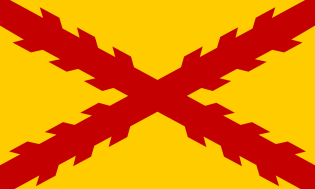Spanish State: Difference between revisions
mNo edit summary |
mNo edit summary |
||
| Line 9: | Line 9: | ||
*Asturleonese | *Asturleonese | ||
*Aragonese | *Aragonese | ||
*Dozens of Regional Languages|independence=*Dynastic Union | *Dozens of Regional Languages|independence=*Dynastic Union | ||
20 January 1479 | 20 January 1479 | ||
*Sole sovereign | *Sole sovereign | ||
14 March 1516 | 14 March 1516 | ||
*Centralized state | *Centralized state | ||
9 June 1715 | 9 June 1715 | ||
*First constitution | *First constitution | ||
Revision as of 06:24, 15 May 2025
Spain, officially the Spanish State, is a Legacy Nation. It is a Great Power, a member of the Axis Powers, and a Security Council Member of the League of Nations.
History
Pre-First Scinfaxi War
In early antiquity, the Iberian Peninsula on Earth was inhabited by Celts, Iberians, and other pre-Roman peoples. Following the Roman conquest of the Iberian peninsula, the province of Hispania was established. Following the Romanisation and Christianisation of Hispania, the fall of the Western Roman Empire ushered in the inward migration of tribes from Central Europe, including the Visigoths, who formed the Visigothic Kingdom centred on Toledo. In the early eighth century, most of the peninsula was conquered by the Umayyad Caliphate, and during early Islamic rule, Al-Andalus became a dominant peninsular power centred on Córdoba. Several Christian kingdoms emerged in Northern Iberia, chief among them Asturias, León, Castile, Aragon and Navarre; made an intermittent southward military expansion and repopulation, known as the Reconquista, repelling Islamic rule in Iberia, which culminated with the Christian seizure of the Nasrid Kingdom of Granada in 1492. The dynastic union of the Crown of Castile and the Crown of Aragon in 1479 under the Catholic Monarchs is often considered the de facto unification of Spain as a nation state.
During the Age of Discovery, Spain pioneered the exploration and conquest of the New World, made the first circumnavigation of the globe and formed one of the largest empires in history. The Spanish Empire reached a global scale and spread across all continents, underpinning the rise of a global trading system fueled primarily by precious metals. In the 18th century, the Bourbon Reforms, particularly the Nueva Planta decrees, centralized mainland Spain, strengthening royal authority and modernizing administrative structures. In the 19th century, after the victorious Peninsular War against Napoleonic occupation forces, the following political divisions between liberals and absolutists led to the breakaway of most of the American colonies.
